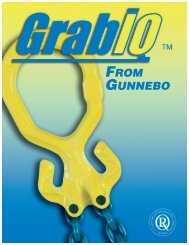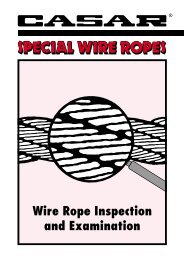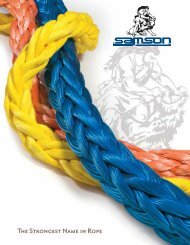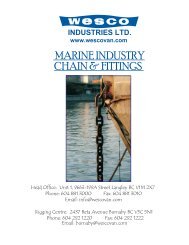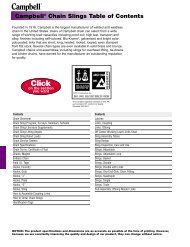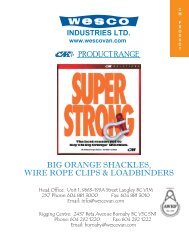Python Wire Rope - Wesco Industries Ltd.
Python Wire Rope - Wesco Industries Ltd.
Python Wire Rope - Wesco Industries Ltd.
You also want an ePaper? Increase the reach of your titles
YUMPU automatically turns print PDFs into web optimized ePapers that Google loves.
<strong>Wire</strong> <strong>Rope</strong> Construction<br />
Sheaves and Drums<br />
The performance of all wire rope depends on the good<br />
condition and sufficient dimensions of sheaves and drums.<br />
Too small sheaves and drums will reduce the service life<br />
of a rope. This is more a question of ‘performance’ rather<br />
than ‘safety’. The following table is based upon<br />
recommendations by the <strong>Wire</strong> <strong>Rope</strong> Technical Board:<br />
Suggested<br />
Construction D/d ratio<br />
19x7 / 18x7 34<br />
6x26 WS 30<br />
6x25 Filler, 6x31 WS, Compac ® 626 26<br />
6x36 WS, <strong>Python</strong> ® HS9, <strong>Python</strong> ® Ultra 23<br />
8x25, <strong>Python</strong> ® Super 8, <strong>Python</strong> ® Multi 20<br />
<strong>Python</strong> ® Compac 35, <strong>Python</strong> ® Lift and Hoist 20<br />
Recommended Sheave and Drum Contours:<br />
Groove radii minimum: o.53 to .535x d for new rope<br />
Groove radii maximum: o.55 to o.56x d<br />
Sheave Groove depth: 1.5 x d<br />
Drum Pitch for SINGLE layer minimum: 2.065 x groove radii<br />
Drum Pitch for SINGLE layer maximum: 2.18 x groove radii<br />
Drum groove depth: minimum ≥ o.375x d for helical grooved<br />
Hardness: As wire rope has a hardness of about 50-55RC we<br />
recommend that the hardness of sheaves and drums is at least<br />
35 RC, better is 40-45 RC<br />
Sheave opening angle should be 35˚ to 45˚ for applications<br />
with fleet angles ≤ 1.5˚, for larger fleet angles use 60˚<br />
opening.<br />
Maximum rope fleet angle for general purpose ropes<br />
should not exceed 4˚, for non-rotating/rotation resistant<br />
types and for <strong>Python</strong> ® HS-9 and <strong>Python</strong> ® Ultra the fleet<br />
angle should not exceed 1.5˚<br />
Sheaves and Drums<br />
Multi-layer drum systems should use diedrawn<br />
(<strong>Python</strong> ® Compac 35) or type ‘V’<br />
<strong>Python</strong> ® rope constructions having a steel<br />
core. The higher fill factor of such rope<br />
constructions ensure a greater resistance<br />
to crushing and flattening than<br />
conventional rope types. This is particularly<br />
important for boom hoist ropes on lattice<br />
boom cranes at the cross over point from<br />
one rope winding to the next.<br />
Cranes equipped with multi-layer drum<br />
systems which require rotation-resistant or<br />
non-rotating rope are best served with<br />
<strong>Python</strong> ® Compac 35 or <strong>Python</strong> ® Lift rope<br />
constructions as these have a smooth<br />
outer surface allowing the rope to better<br />
‘glide’ from one winding into the next.<br />
To further reduce drum crushing have the<br />
first rope layer wound onto the drum with<br />
about 5-10% of the WLL and avoid that this<br />
first layer unspools and re-spools without<br />
tension. This would cause a ‘soft’ bottom<br />
layer which will flatten rather quickly.<br />
<strong>Python</strong> ® ropes also help reduce strand<br />
interlocking which normally occurs at<br />
adjacent rope wraps. This is caused by too<br />
large of fleet angles as well as is the cause<br />
of multiple layer windings on smooth<br />
(ungrooved) drums.<br />
All <strong>Python</strong> ® ropes have a smooth and very<br />
round outer rope surface which helps to<br />
minimize abrasive wear due to strand-tostrand<br />
contacts.<br />
For further information please refer to<br />
our Catalogue ‘Handling Procedures’.<br />
-13-



